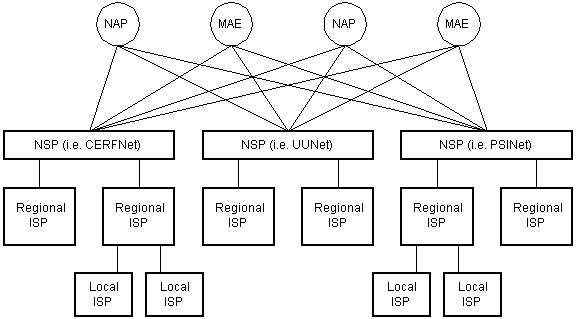Internet Infrastructure
The Internet backbone is made up of many large networks which interconnect with each other. These large networks are known as Network Service Providers or NSPs. Some of the large NSPs are UUNet, CerfNet, IBM, BBN Planet, SprintNet, PSINet, as well as others. These networks peer with each other to exchange packet traffic. Each NSP is required to connect to three Network Access Points or NAPs. At the NAPs, packet traffic may jump from one NSP's backbone to another NSP's backbone.
NSPs also interconnect at Metropolitan Area Exchanges or MAEs. MAEs serve the same purpose as the NAPs but are privately owned. NAPs were the original Internet interconnect points. Both NAPs and MAEs are referred to as Internet Exchange Points or IXs. NSPs also sell bandwidth to smaller networks, such as ISPs and smaller bandwidth providers. Below is a picture showing this hierarchical infrastructure.

This is not a true representation of an actual piece of the Internet. Diagram above is only meant to demonstrate how the NSPs could interconnect with each other and smaller ISPs. None of the physical network components are shown in this diagram as they are before. This is because a single NSP's backbone infrastructure is a complex drawing by itself. Most NSPs publish maps of their network infrastructure on their web sites and can be found easily. To draw an actual map of the Internet would be nearly impossible due to it's size, complexity, and ever changing structure.
